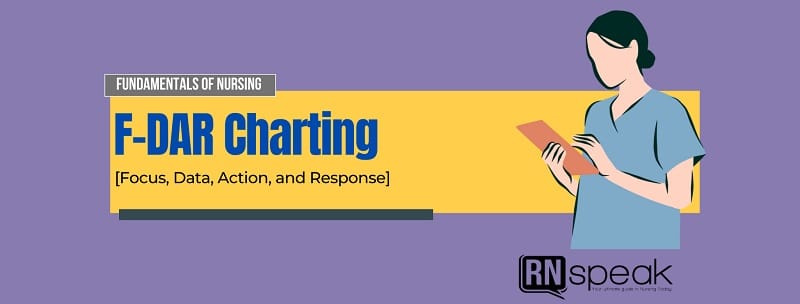Focus charting or simply termed as F-DAR is a kind of documentation utilizing the nursing process and involves the four steps: assessment, planning, implementation, and evaluation. It is a systematic approach. It is focused on the care of the client and related strengths or concerns. One F-DAR charting is solely concerned with one particular problem or situation and is meant to be concise. It is also used to consolidate the patient’s health record and information.
Parts of an FDAR Charting
There are three columns utilized for FDAR charting during documentation in the Nurse’s Notes section of the chart:
- Date and Hour
- Focus
- Progress Notes
| Date and Time | Focus | Progress Notes |
| Ex:
7/17/2013 7:15am |
The Focus of Care
( can be a nursing diagnosis )
|
Data Action Response
|
Data
As compared to the nursing process, it is similar to the assessment stage. In the data part, assessment clues like vital signs, observable change in the condition and altered behavior are written. Assessment cues include both objective and subjective data.
Action
The action part is comparable to the planning and implementation stages of the nursing process, involving the current and possible nursing actions. This can include interventions and procedures performed. It may also contain the alterations necessary for the patient’s plan of care.
Response
The evaluation stage of the nursing process is like the response part of the charting. It gives a detailed and accurate reaction of the patient to the nursing action done. This will also reflect the condition of the patient after the interventions.
F-DAR Sample Charting
The following are examples of charting for the FDAR method:
|
DATE/SHIFT/TIME |
FOCUS |
PROGRESS NOTES |
|
08/18/13 7-3pm 8:15am
8:20am 8:50am
11:45am |
Difficulty of Breathing |
D: “I’m out of breath,” as verbalized. RR = 30, SpO2 = 90%. Use of accessory muscles when breathing. Slightly dyspneic. A: Assisted on high backrest. Administered Oxygen inhalation at 6 Liters/min via face mask. Advised to do deep breathing exercise. Encouraged to avoid strenuous activities. R. RR = 18, SpO2 = 97%. Normal spontaneous breathing noted. Charity F. Marquez, R.N. |
|
DATE/SHIFT/TIME |
FOCUS |
PROGRESS NOTES |
|
08/18/13 7-3pm 8:55am
9:15am
10:30am
2:45pm |
Low Blood Pressure |
D: “Nurse, I’m feeling dizzy. I can’t stand on my own,” as verbalized. Blood pressure of 70/50 mmHg. Pale and weak looking. A: Assisted in the modified Trendelenburg position. Advised to wriggle legs on the bedside before ambulating and to avoid sudden change of position. Regulated IVF at the prescribed rate. Provided rest periods. R: Blood pressure of 110/70mmHg. No dizziness reported. Charity F. Marquez, R.N. |












